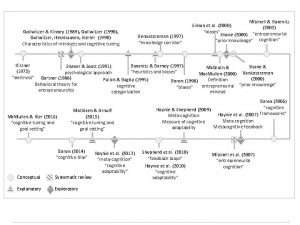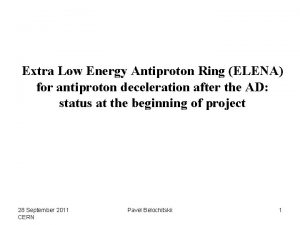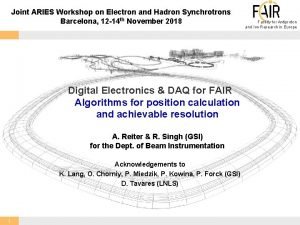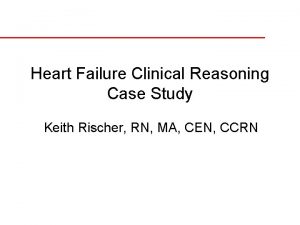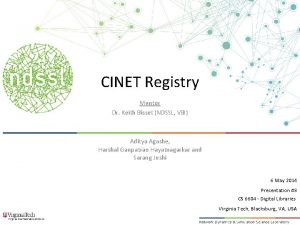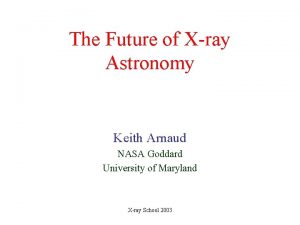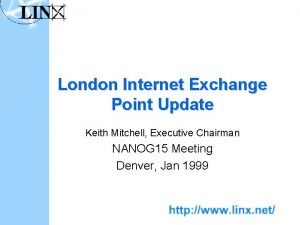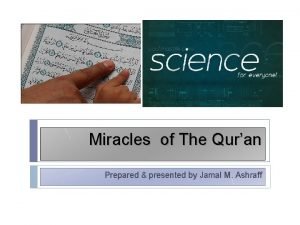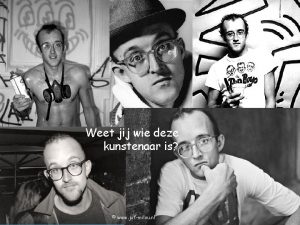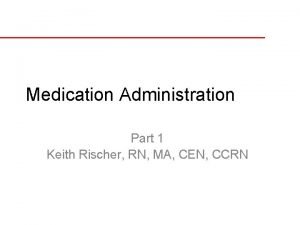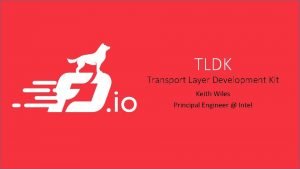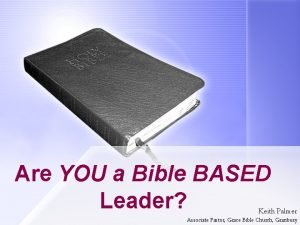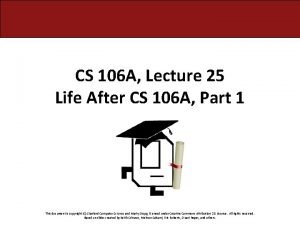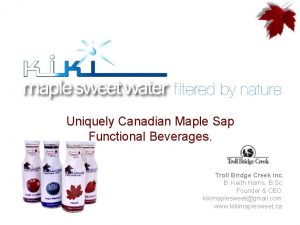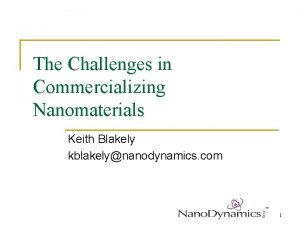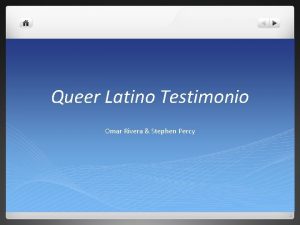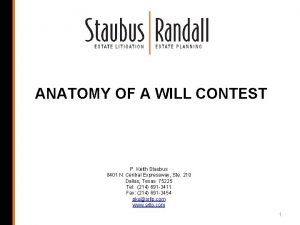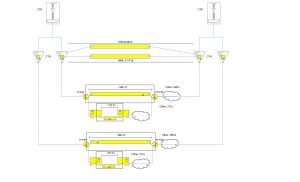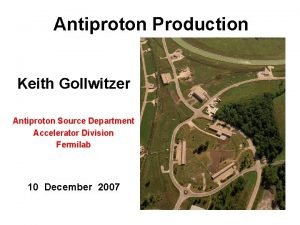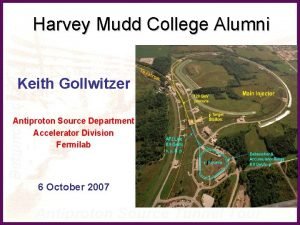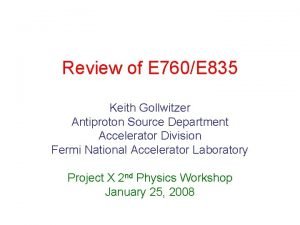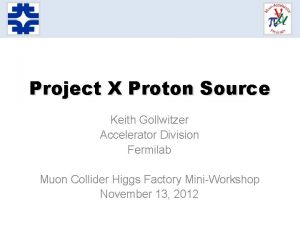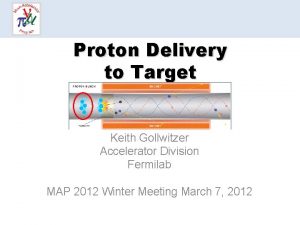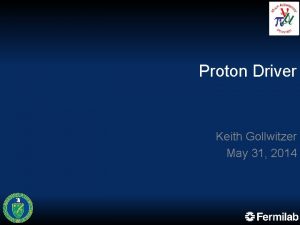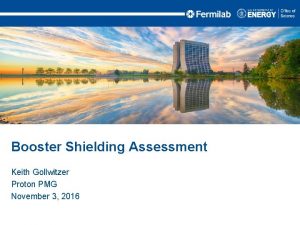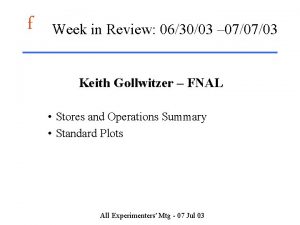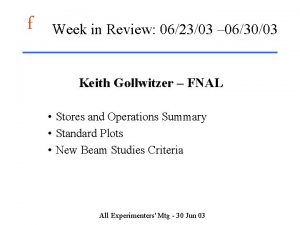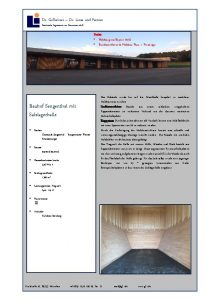What is an Antiproton Keith Gollwitzer Antiproton Source





































- Slides: 37

What is an Antiproton? Keith Gollwitzer Antiproton Source Department Accelerator Division Fermilab 8 August 2009

What is an Antiproton? • Government issued Webster’s Dictionary: – “The antiparticle of the proton” • Antiparticle definition “subatomic particle having the same mass, average lifetime, spin, magnitude of magnetic moment but opposite direction, magnitude of electric charge but opposite sign, opposite intrinsic parity” • What about “Antimatter”? – “Matter made from antiparticles” • What is a Pbar? – Shortened name for Antiproton based upon symbol used in physics p for proton – Over-line or bar above symbol means “anti” p for antiproton

• So what are protons? – With neutrons form different atomic nuclei • Simplest is Hydrogen nucleus of a single proton – Made up of quarks (up and down) • Proton is uud • Neutron is ddu • Antiproton is uud – Antiquarks

Matter and Antimatter • Matter – Plentiful and “free” by separating hydrogen components • 13. 6 e. V to ionize electron from proton • Antimatter – Scarce in nature • Created by cosmic rays interacting with the atmosphere. – The original “Fixed Target” experiment • Positrons are by product of normal everyday radioactivity • Particle & Antiparticle when they met --- annihilate – Who first informed us of this?

Where else Antimatter recently? • Dan Brown’s Angels & Demons • We will come back to this later • Move back to reality and what Fermilab does

History: Particle Collisions • Originally studied Cosmic Ray Particles Cosmic rays are energetic • No human control of energy, type, when – Detection done at high altitudes – Discovered many types of particles that are not everyday matter • Accelerators allow control of collisions – Allowed study of many new particles • Some with masses greater than the initial particles

Fermilab Collisions • Fixed Target – In the Fixed Target mode, ½ of the experiment is at rest. – The other ½ is moving at high energy. – There is a big “relativistic” penalty to be paid because of the conservation of momentum. • Collider Mode – In the Collider mode, two particles of equal mass and energy travel directly at each other. – The total momentum of the system is zero, so there is no “relativistic” penalty to be paid. – Most of the energy goes directly into making new particles.

Particle Acceleration • A charged particle will be accelerated by a voltage potential. + – Opposite charges attract. • One electron Volt (e. V) is the energy gained by an electron (or any particle of unit charge) when it is accelerated through a potential of 1 Volt. -

To Higher Energies Scientific Prefixes K (kilo) 1, 000 M (mega) 1, 000 G (giga) 1, 000, 000 T (tera) 1, 000, 000 Te. Vatron accelerates beam to nearly 1 trillion electron Volts Batteries are 1 Volt per inch A trillion inches is 15. 8 million miles

First Stage of the Acceleration • Crockoft-Walton Accelerator – Can be thought of as a 750, 000 V DC voltage source. – The maximum voltage is limited by how much the air can “stand-off” before sparking.

Second Stage of Acceleration • A linear accelerator (LINAC)

Drift Tube Linac

Synchrotrons • • The Fermilab Linac is 130 meters long and reaches an energy of 400 Me. V (1 million Volts per foot) To get to 980 billion volts, a Linac would have to be – 200 miles long at 1 million Volts per foot • What about using the Linac over and over? – The drift tube spacing at the beginning of the Linac would be wrong for higher energy particles • But a Synchrotron could be used! – Dipoles are used to bend particles – Quadrupoles are used to focus particles – RF cavities are used to accelerate particles

Dipole Magnets • Dipole magnets are used to bend the particle’s path • The magnet body confines or concentrates the magnetic field • The pole faces shape the magnetic field

Quadrupole Magnets • Quadrupoles are needed for focusing particles • Not all the particles are on the “perfect” orbit. – If the particle is on the right orbit – don’t bend. – If the particle is on the inside – bend to the outside. – If the particle is on the outside – bend to the inside.

Pre-Acc First stage of acceleration Start with Hydrogen Bottle Final Energy = 750 Ke. V

Linac Final Energy of 400 Me. V

Booster Ring Final Energy of 8 Ge. V Uses combined function magnets

Main Injector Ring Final Energy of 150 Ge. V 2 mile circumference Upper ring is the Recycler

Final Energy of 980 Ge. V Tevatron Ring 4 mile circumference Uses cryogenic superconducting dipoles

Fixed Target Beam Lines Fixed Target program has run at 800 Ge. V and currently at 120 Ge. V Neutrino Program runs at two different energies 8 Ge. V and 120 Ge. V

Antiproton Source 120 Ge. V protons from Main Injector hit (fixed) production target. Antiproton Source beam lines and rings capture and collect 8 Ge. V pbars are sent to the rest of accelerator complex to be injected into the Tevatron for the collider program

The Antiproton Target Station 29 cm 81 cm Pulsed Magnet Li Lens Nickel Alloy with air cooling through the copper disks After Before Target 3°

The Antiproton Target Station 29 cm 81 cm Pulsed Magnet Li Lens Target 3°

“Hot” Beam • The pbars leave the target at a wide range of energies, positions, and angles. • This randomness is equivalent to temperature. The pbar beam is “hot” coming off the target. – This “hot” beam will have a difficult time fitting into a beam pipe of reasonable dimensions. – Also, this “hot” beam is very diffuse and not very “bright”. Bright beams are needed in the collider in order to increase the odds that the particles collide with particles in the other beam • Stochastic cooling is a technique that is used to remove the randomness of the “hot” beam on a particle by particle basis.

Stochastic Cooling • Stochastic cooling uses feedback • A pickup electrode measures an “error” signal for a given pbar. – This error signal could be the pbar’s position or energy – The pickup signal can be extremely small, on the order of 1 p. W – The Debuncher pickups are cooled to 4 Kelvin to reduce the effect of thermal noise and 300 Kelvin “shine” • This signal is processed and amplified – The gain of the Debuncher systems is about 150 d. B • The opposite of the error signal is applied to the pbar at the kicker – The kicker signal can be as large as 2 k. W

Stochastic Cooling Pickups

Stacking Cycle - Debuncher • Every 2. 2 seconds – 8 x 1012 (8 trillion) 120 Ge. V protons onto target – Beam line transfers negatively charged 8 Ge. V particles to the Debuncher 8 (250 million) 8 Ge. V – 2. 5 x 10 • Other particles decay or pbars circulate in the radiate away in a few turns Debuncher • Beam circulates every 1. 6 microseconds – 0. 0000016 seconds • Stochastic cooling reduces the phase space by a factor of ten – Transfer all pbars to the Accumulator

Stacking Cycle - Accumulator • RF system decelerates from injection to deposition orbit • Stochastic Cooling • 2 -4 GHz stacktail – Pushes and compresses beam into the core • 2 -4 & 4 -8 GHz core momentum – Gathers beam from the stacktail • 4 -8 GHz transverse slotted waveguide pickups Cyan = After injection before RF capture Green = After RF is turned off – Increase particle density by factor of 5000 – Factor of 3 -5 decrease in both transverse phase space dimensions

Total Antiprotons at Fermilab • Accumulation rate of 2. 5 x 1011 (250 billion) antiprotons per hour • When reach 4 x 1011 (400 billion) pbars, transfer beam out of the Accumulator to the Main Injector into the Recycler Ring for storage until needed for the Tevatron collider program • Most number of antiprotons that have been on site at Fermilab at one time (Accumulator, p Recycler and Tevatron) – 6 x 1012 (6 trillion) pbars • 10 pg = 0. 000 000 01 grams • In 2008 produced – 1400 trillion pbars (2. 3 ng) p p p

Using Antiprotons • Antiprotons are collected in Recycler Ring at 8 Ge. V for a day • Then antiprotons are sent in 36 batches to Main Injector to be accelerated to 150 Ge. V • Antiprotons are transferred to the Tevatron which already has 36 proton batches • Both beams are accelerated to 980 Ge. V

Tevatron Collider • Two beams in one accelerator going in opposite directions! – Electrostatic separators keep beams on different helical orbits during acceleration • Bring beams into collisions by collapsing helix orbits at desired interaction points – Middle of detectors

Angels & Demons + Antiprotons • Page of “Facts” in a book of fiction • Antimatter exists • 0. 25 grams of antimatter mixed with 0. 25 grams of matter would produce an explosion equivalent Hiroshima (wipe out the Vatican)

Angels & Demons + Antiprotons • Can easily produce 0. 25 grams of antimatter – Fact: Fermilab is the world leader for producing antiprotons/antimatter – It would take 100 million years • Can easily transport that much antimatter – Fact: Fermilab’s bottles are over 6 miles of rings • It would cost a lot *2940 trillion $ ~ 420 x U. S. GNP

Antimatter Uses • Scientific Studies – Laboratories use antimatter to collide with matter – Study why no antimatter today • Applications Courtesy NIH – Example is Positron Emission Tomography (PET Scans) • Not Spaceships

Safety You will be on tours in different areas – Including into the Antiproton Source tunnel • No smoking, eating or drinking in the tunnel enclosure • Please be careful on the stairs and walking – Edges of components and cables do stick out Tunnel is hot – 90 o. F!

Today Enjoy your time at Fermilab Please take pictures Please ask questions Hope that you have learned a little about antiprotons, particle accelerators and what goes on at Fermilab
 Gollwitzer 1990
Gollwitzer 1990 Low energy antiproton ring
Low energy antiproton ring Aries bpm
Aries bpm Keith wagner classification
Keith wagner classification Keith rn heart failure case study
Keith rn heart failure case study Keith naunton
Keith naunton Keith haring pronunciation
Keith haring pronunciation Vu's familie
Vu's familie Keith foord
Keith foord Dr keith wallace
Dr keith wallace Keith keeler
Keith keeler Ndssl
Ndssl Keith arnaud
Keith arnaud Keith burke ucc
Keith burke ucc Keith mitchell stock exchange
Keith mitchell stock exchange Keith sweat twisted mp3
Keith sweat twisted mp3 Professor emeritus keith l. moore
Professor emeritus keith l. moore Juf milou pop art
Juf milou pop art Keith burns architect
Keith burns architect Keith balla
Keith balla Amiodarone side effects
Amiodarone side effects Keith steinmetz
Keith steinmetz Gas fundies
Gas fundies Tldk
Tldk Charles & keith singapore
Charles & keith singapore Keith palmer pastor
Keith palmer pastor Keith schwarz stanford
Keith schwarz stanford Keith haring blue chair
Keith haring blue chair Minor keith
Minor keith Troll rysunek
Troll rysunek Dr keith blakely
Dr keith blakely Keith lodhia
Keith lodhia Agile krc
Agile krc Keith haring characteristics
Keith haring characteristics Juanito xtravaganza rivera
Juanito xtravaganza rivera Home insurance in beasley
Home insurance in beasley Keith staubus
Keith staubus What it represents
What it represents
